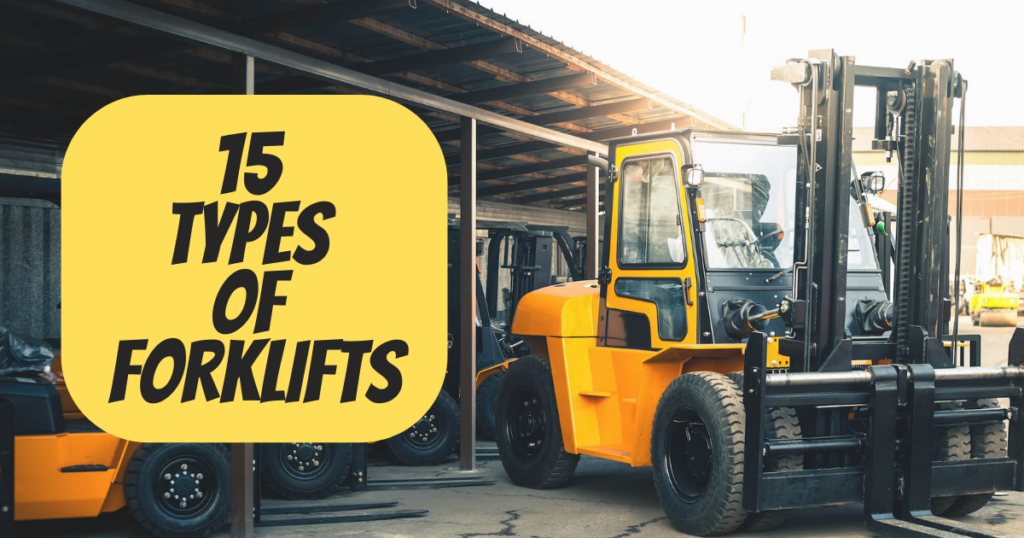
Forklifts have become indispensable machines in various industries, revolutionizing material handling and enhancing operational efficiency. With their ability to lift, transport, and stack heavy loads, forklifts play a crucial role in warehouses, distribution centers, construction sites, and manufacturing facilities worldwide.
However, not all forklifts are created equal, as they come in various types and configurations tailored to specific applications. Therefore, understanding the difference between forklift types is essential for businesses and operators seeking the right equipment for their unique operational needs.
In this article, we will explore the various types available today. We will discuss their uses and characteristics in detail. Read on to find out about the 15 most common types of forklifts used nowadays.
15 Most Common Types of Forklifts
Here are the most common types of forklifts available nowadays:
1. Warehouse Forklift:
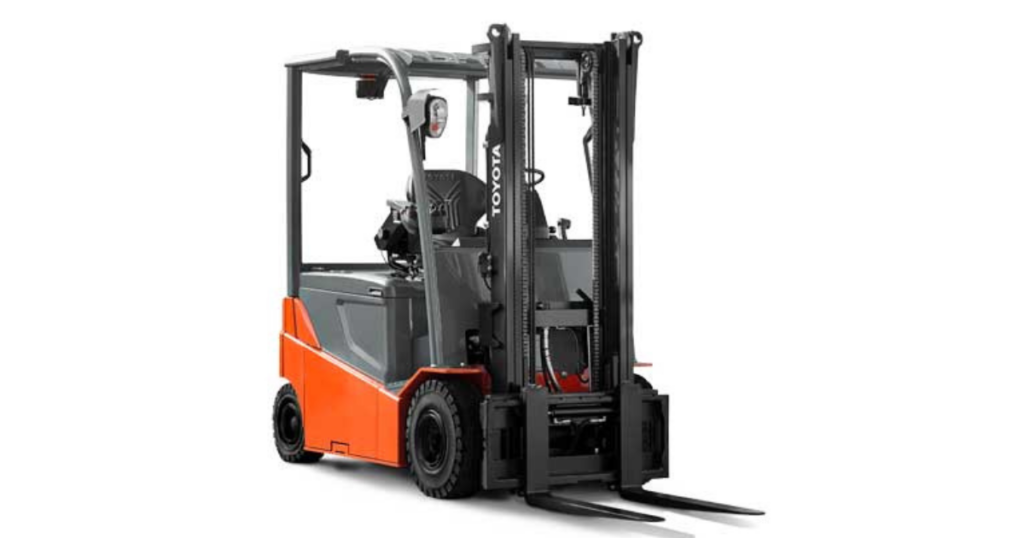
The warehouse forklift is widely recognized as the standard type of lift truck commonly seen in various industrial settings. Its appearance resembles that of a golf cart, featuring dual forks extending from the front. Primarily used in facilities with an extensive inventory, this forklift excels in loading and unloading pallets and transporting items to and from delivery vehicles.
When it comes to popular models, the Hyster 36-38T, Komatsu 20 BX50 Hyster, and Toyota 3-Wheel Electric Forklift are among the top choices for warehouse operations. While most industrial forklifts have a lifting capacity of 5,000 pounds, heavy-duty variants can handle loads of up to 25,000 pounds.
Related: How Wide Is A Concrete Truck | Types & Dimensions
2. Side Loader:

Side loader forklift trucks are designed for efficient operation in narrow aisles, making them an ideal choice for handling materials in space-constrained environments. Unlike traditional forklifts, the forks of side loaders are mounted to the side of the truck, enabling them to lift and transport wide or long loads that would otherwise be challenging or inaccessible with a conventional forklift.
Two main types of side loader forklifts are available: the enclosed cab version, commonly used outdoors, and the stand-up version, which is more suitable for indoor tasks. Additionally, there is a multi-way variant equipped with wheels that rotate by 90°, allowing for easy movement in any direction.
The timber industry prominently utilizes side loaders due to their exceptional capability to carry long and heavy loads within narrow aisles. Top manufacturers of side loader forklifts include Toyota, Raymond, Yale, and Hyundai, known for their reliable and high-quality equipment.
3. Counterbalance Forklift:

The counterbalance forklift is a widely used type of lift truck distinguished by its front forks and a counterbalancing weight at the back. Unlike forklifts with extending arms, counterbalance forklifts can move directly toward the load without any obstructions.
There are several variations of counterbalance forklifts available. The 3-wheel version is particularly suitable for tasks that involve frequent turning and maneuvering in tight spaces. On the other hand, the stand-up counterbalance forklift enables operators to easily mount and dismount the truck between loads, enhancing efficiency.
Notable manufacturers of counterbalance forklifts include Mitsubishi, Toyota, and Crown, renowned for their expertise in producing reliable and high-performance equipment.
4. Telehandler:
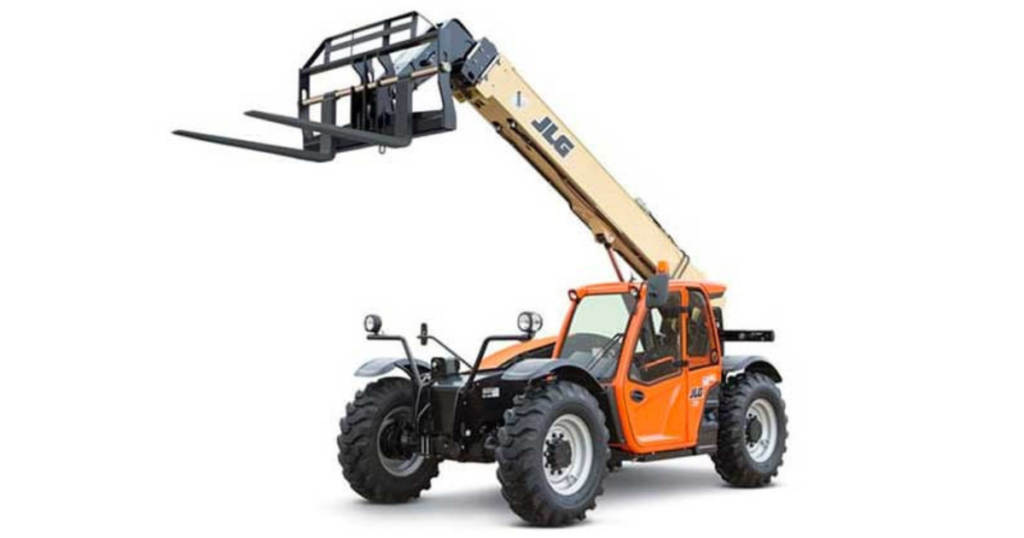
The telehandler, also called a telescopic forklift, combines the functionalities of a crane and a forklift with its extendable arm and boom. The extendable arm has twin forks to lift pallets off the ground. This versatile machine excels at reaching tight spaces and handling materials from odd angles.
Standard telehandlers typically have a lifting capacity of 5,500 lbs and can elevate materials up to 19 feet in the air. They are well-suited for various applications where maneuverability and reaching capabilities are essential.
As the popularity of telehandlers continues to grow, renowned manufacturers such as JCB, Genie, Bobcat, Haulotte, and Caterpillar offer a diverse range of high-quality telehandler models. For larger capacity jobs, models like the JLG 1644 are highly adept, while others can lift loads up to an impressive height of 55 feet.
5. Heavy-Duty Forklift:

The heavy-duty forklift, also known as a large-capacity forklift, combines features from both the warehouse forklift and the telehandler. While it cannot reach difficult angles like a telehandler, it compensates by offering the capability to lift significantly heavier loads to greater heights than a warehouse forklift.
Typically, heavy-duty forklifts have a maximum lift capacity starting from 30,000 lbs, although such power is usually required for specialized jobs. As a result, the scope of heavy-duty forklifts is narrower compared to telehandlers and warehouse forklifts.
In the market, there are approximately 20 popular manufacturers of heavy-duty forklifts. Prominent names in the industry include NACCO Industries and Mitsubishi. Several models these manufacturers offer boast impressive lifting capacities, reaching 36,000 lbs.
6. Rough Terrain Forklift:

The rough terrain forklift, also referred to as a straight mast forklift, is specifically designed for outdoor job sites that feature uneven surfaces. These forklifts are equipped with robust pneumatic tires that are oversized and threaded, providing improved balance and stability to navigate rocky terrain while transporting materials safely.
Popular models in this category include the JCB 950 and CASE 588H, offering options for four-wheel drive. One significant advantage of rough terrain forklifts is their ability to lift heavier loads. Most models have a lifting capacity of either 6,000 or 8,000 lbs, making them suitable for demanding outdoor tasks.
The specialized features and capabilities of rough terrain forklifts cater to the unique challenges posed by outdoor environments, providing reliable and efficient material handling solutions for construction sites and other rough terrain applications.
7. Pallet Jack:

Pallet jacks, also called pump trucks, are specialized forklifts with limited lifting capacity due to their compact size. However, they offer the advantage of fitting into tight spaces and lifting smaller loads in confined areas.
Although pallet jacks may lack power and maneuverability, they are more cost-effective to acquire or rent than other options. Some well-known models of pallet jacks include the Mighty Lift 20 x 36 Inch Pallet Truck and the Vestil Electric Pallet Truck. Buyers and renters have the choice between manual pallet jacks and electric ones.
Related: 15 Best Electric Trucks For 2023 | Specs & Comparison
8. Walkie Stacker:
Walkie stackers are distinctive in appearance and serve a specific purpose in material handling. Unlike other types of forklifts, these vehicles do not have enclosed cabs. Instead, the operator walks behind the stacker and controls it using a handle attached to the equipment.
While walkie stackers may lack power, maneuverability, and speed, they are particularly useful when there is a need for a pallet jack with greater height capabilities. Walkie stackers can lift loads to higher levels compared to traditional pallet jacks.
Prominent manufacturers of walkie-stacker forklifts include Hyster, Jungheinrich, and Toyota. For example, Toyota offers the 6BWC20 model, which is well-suited for handling 4,000-pound loads. On the other hand, Jungheinrich’s EMC 110 is designed for navigating narrow aisles.
9. Order Picker:

An order picker is a specific type of walkie-stacker used to pick up and transport materials from storage locations. These machines are capable of reaching impressive heights, with the ability to elevate operators up to 32 feet to access warehouse racks and retrieve individual units.
Order pickers are particularly advantageous in customer order warehouses and storage facilities where the requirement is to retrieve individual units without bringing down entire pallets. They offer versatility in handling items of different sizes, from auto parts to furniture.
10. Reach Fork Truck:

The reach forklift is a specialized vehicle primarily used for indoor warehouse operations. Its unique feature is the extension of its forks beyond the truck’s compartment, enabling it to reach deep into warehouse racks in a manner that standard forklifts cannot. This allows for movement in horizontal (X) and vertical (Y) directions at heights of up to 30 feet.
They also feature an open operator compartment, providing better visibility for the operator. However, it is essential to note that reach trucks have limited undercarriage clearance, making them unsuitable for outdoor tasks. Typically, these fork-reach trucks can handle loads ranging from 2,000 to 5,000 lbs. Leading manufacturers of high-quality reach forklifts include UniCarriers, Clark Materials, and Yale.
11. Industrial Forklift:

An industrial forklift, or a large-capacity forklift, is designed to handle significantly heavier payloads and has a higher lifting capacity than warehouse forklifts. It can lift much larger weights to greater heights than other forklifts. As a result, the industrial forklift is often described as a hybrid between a telehandler and a warehouse forklift.
Industrial forklifts are commonly utilized on construction sites due to their size and robust construction, enabling them to carry heavy loads across rough terrain and cover longer distances.
They can move various materials found on construction sites, including pallets of bricks, steel joists, wood and steel beams, stones, and drywall. These machines can unload materials and transport them directly to the specific location on the site where they are required.
12. Pneumatic Tire Forklifts:
A pneumatic tire forklift is a type of forklift that utilizes tires filled with air, similar to the tires on a regular truck. The unique feature of pneumatic tires is their ability to provide a firm grip on surfaces and terrains that are slippery or uneven. This enhanced grip is achieved through the tires’ design, which is longer and wider than cushion tires.
There are two main types of pneumatic tires for forklifts: solid pneumatics and air pneumatics. Solid pneumatic tires are made entirely of rubber, making them ideal for environments such as construction sites where sharp objects like nails could easily puncture a tire.
However, they tend to be more expensive. On the other hand, air pneumatics are well-suited for conditions like asphalt or outdoor warehouses and supply yards. While there is a risk of puncture with air pneumatics, they are highly beneficial for terrains that may be slippery or uneven.
13. Cushion Tire Forklifts:

Cushion tire forklifts are a type of forklift that features solid rubber tires. Unlike pneumatic tire forklifts, which have tires filled with air, cushion tire forklifts have tires made of solid rubber. The term “cushion” refers to the cushioning effect provided by solid rubber tires.
Cushion tire forklifts are designed for indoor use on smooth, flat surfaces such as warehouses, manufacturing facilities, and distribution centers. Solid rubber tires offer stability and maneuverability in these controlled environments. They are well-suited for applications that involve loading and unloading goods on concrete or asphalt surfaces.
Due to their compact size and maneuverability, cushion tire forklifts are often preferred for operations in tight spaces. Their smaller turning radius allows them to navigate narrow aisles and confined areas more easily than other forklifts.
14. Articulated Forklifts:
An articulated forklift can be advantageous when a regular forklift is too large or when enhanced maneuverability is required. It has a forked lifting mechanism that can turn left independently or right, separate from the truck’s main body.
This enables the operator to drive in a straight line while simultaneously maneuvering the forks to access loads or staging areas. Articulated forklifts find utility in loading and unloading trailers in compact spaces and operating in warehouses, cold storage units, and factories.
They are especially beneficial in applications where space optimization and efficient utilization of storage areas are crucial. It’s worth noting that while articulated forklifts excel in maneuverability and operate in narrow spaces, they may have limitations in terms of lifting capacity compared to larger, traditional forklifts.
15. Explosion-Proof Forklifts:

Explosion-proof forklifts are utilized when there is a need to minimize the risk of explosions or fires. One such scenario is in a paint factory, where flammable and combustible materials are stored. In such environments, employing an explosion-proof forklift becomes advantageous.
These specialized forklifts are equipped with sealed electrical components and non-sparking bronze elements, replacing traditional metal parts. Additionally, they are equipped with monitors that automatically shut down the machine if hazardous gases are detected in the atmosphere.
Explosion-proof forklifts find application in various industries, including producing, handling, processing, and storing perfumes, cosmetics, paints, printing inks, pharmaceuticals, and rubbers.
Classes of Forklift:

There are several classes of forklifts, including:
- Class I: Electric Motor Rider Forklifts
- Class II: Electric Motor Narrow Aisle Forklifts (Reach Trucks, Order Pickers)
- Class III: Electric Pallet Jacks, Stackers, and Tow Tractors
- Class IV: Internal Combustion Cushion Tire Forklifts
- Class V: Internal Combustion Pneumatic Tire Forklifts
- Class VI: Electric/IC Engine Tow Tractors
- Class VII: Rough Terrain Forklifts
Elements of a Forklift:
When selecting a forklift, it is essential to consider its key components, such as lift capacity, load center, and stability. Each forklift model has different capabilities in these areas, which must be carefully evaluated before deciding.
- Lift Capacity: refers to the maximum weight a forklift can safely lift and carry.
- Load Center: The load center is the horizontal distance from the load’s center of gravity to the front edge of the forks.
- Stability Triangle: The space beneath the forklift preserves its center of gravity and safeguards against tipping by maintaining stability.
How to choose the right forklift?

Here are some factors to consider while choosing the right forklift for a specific purpose:
- Lifting Capacity: Consider the lifting capacity required for your tasks.
- Site’s Stability: Evaluate the stability of the job site to ensure it can support the forklift.
- Height of the Space: Assess the height restrictions of the workspace to ensure the forklift can maneuver through openings.
- Fuel Type: Choose the appropriate fuel type based on your needs, such as battery-powered or gas-powered.
- Terrain Conditions: Analyze the terrain conditions to determine if the surface is even or uneven.
Conclusion
In conclusion, forklifts offer various options to cater to diverse industrial needs. Each type of forklift brings its own set of advantages and capabilities to the table. From the quiet efficiency of electric forklifts to the rugged versatility of rough terrain models, there is a forklift type to suit every industrial need.
Understanding the different types of available forklifts helps industries make informed decisions to enhance productivity, safety, and efficiency in their material handling operations. We have narrowed down a comprehensive list of types of forklifts with their specific features and limitations. You can use this guide to choose the right forklift for your company.


